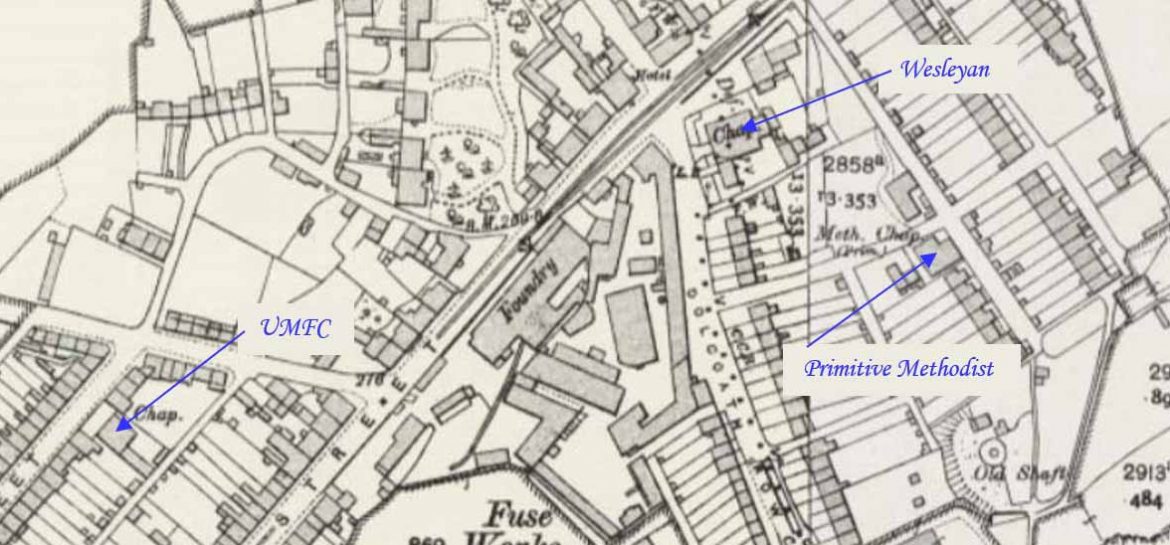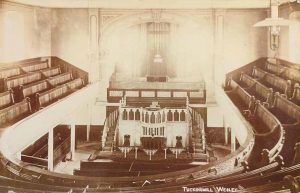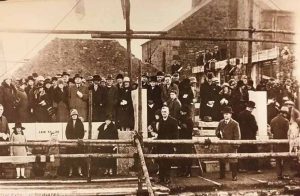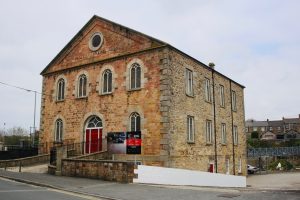
Tuckingmill is a village in the civil parish of Camborne. This profile of Tuckingmill Wesleyan Chapel has been compiled by Jo Lewis and Tony Mansell.
1797 Chapel
The Circuit archives hold the original licence from the Bishop of Exeter, dated 1797, for the Tuckingmill Methodists to worship as a congregation of Protestants dissenting from the Church of England so this dates the first chapel in the village. Its site was very close to the now closed large chapel and is thought to have been on the opposite side of the road.
The origins of Methodism in Tuckingmill go right back to the early days and have a very historic pedigree indeed. In July 1743 the younger of the two clerical Wesley brothers, Charles, was on a preaching tour of Cornwall and attempted to preach in Illogan parish. He was prevented from doing so by one of the Illogan churchwardens, possibly Abel Angove of Trevenson, and escorted out of the parish to the parish boundary with Camborne at Tucking mill. The Illogan officials then adjourned to the public house at Pool and drank at the parish expense. The Illogan churchwardens’ account book from 1702-1787 records under the year 1743 ‘expense at Ann Gartrell’s on driving the Methodists 9 shillings’. Ann Gartrell was the pub landlady. This is one of the first documented pieces of evidence mentioning Methodists in Cornwall and took place within a stone’s throw of the site of large former Wesleyan chapel at Tuckingmill.
Indeed, Charles Wesley in 1743, was driven out of Illogan Parish by the wardens, and prevented from preaching. He watched the Warden go back up the hill, then stepped over the Red River stream and preached. Where he preached is the site of the magnificent 1843 Wesleyan Chapel,
The 1795 Methodist Conference, only four years after John Wesley’s death in 1791, allowed the Societies to have the sacrament of Holy Communion in their own chapels or meeting houses and this led to the building of several new chapels.
The chapel became too small for the congregation.
1843 Chapel
Wesleyan Methodist chapel of 1843, with basement Sunday school and attached later c1825 Sunday school. Extended to the east in c 1900. The original chapel has been converted to commercial premises and the later Sunday school 176485 has been converted to apartments, following use as a chapel. Granite rubble with granite and freestone dressings under a low-pitched roof. Classical style with round-arched openings at the front. 2-storeys-over-basement pedimented front end has 4 windows to 1st floor and 2 windows to ground floor. Wide central doorway with traceried fanlight; late C19 fenestration with traceried heads to 2-light windows. Presumed to have galleried interior, not inspected. Dressed granite ramp and bridge surmounted by wrought-iron railings. Part of an important group of historic buildings including the Bickford Smith (former) Fuse Works.
Tuckingmill’s large Wesleyan Methodist Chapel was built in 1843 with a donation from Edward Burall. It is a pedimented classical box of coursed squared sandstone with granite dressings and a slate roof. The doorway has a raised keystone and very attractive fanlight. When it closed for worship, the Chapel was used for many years as a motor parts warehouse. Despite this change of use, most of the building’s original internal features have survived including a horseshoe gallery on iron Tuscan columns and a large ceiling rose. The Chapel is now vacant and Cornwall Council would like to see the building, which forms part of a prominent group of listed buildings in the centre of Tuckingmill, brought back into use. The adjacent Sunday School was converted into student accommodation and this may be an appropriate use for the Chapel itself. Other possibilities include light industrial or office use. In 2000, the Tuckingmill area was identified as a prime site for regeneration and the South West Regional Development Agency, with partners, produced a strategy for the area. (From the SAVE Buildings at Risk Register)
*Update July 2011*: Cornwall Council secured major funding from the Heritage Lottery Fund in 2008 for a Cambourne and Tuckingmill Townscape Heritage Initiative (THI). The Methodist Chapel was identified as a target building for grant-aid and is currently being repaired and restored. Work is expected to finish this August but SAVE will keep a watching brief on the case until the building has a sustainable new use. (Cornwall Heritage Gateway)
 The stained glass continues the glow in the evening in the former 1843 Tuckingmill Wesleyan Chapel, closed and converted into flats. Though not the largest of the Camborne chapels by any means the building continues to have a commanding presence in the settlement of Tuckingmill, which once had no less than three places of Methodist worship. (David Thomas)
The stained glass continues the glow in the evening in the former 1843 Tuckingmill Wesleyan Chapel, closed and converted into flats. Though not the largest of the Camborne chapels by any means the building continues to have a commanding presence in the settlement of Tuckingmill, which once had no less than three places of Methodist worship. (David Thomas)

 “There has been some very useful feedback and information about my post on Tuckingmill Wesleyan chapel so I thought I would say a little more about this vanished place of worship.
“There has been some very useful feedback and information about my post on Tuckingmill Wesleyan chapel so I thought I would say a little more about this vanished place of worship.
The first postcard photograph below is another view of the chapel’s interior taken by W J Caddy of Redruth in about 1910 so it may have been taken on the same occasion as the one in the previous post. This time the photographer has stood in the back of the upstairs gallery so we have a really good view of the upstairs seating arrangements. There were four pews on each side of the gallery facing inwards where there was an excellent view of the preacher and the choir could be heard to advantage. The chapel had a protruding wing at its east end enclosing the organ and there were access stairs to the choir pews. The customary two chairs, often seen in larger chapels, are placed each side of the communion table and some examples of these in Nonconformist places of worship were often very fine pieces of woodwork.
The second postcard image by W J Bennetts of Camborne depicts a very important day in the life of the chapel, one that had been long planned and prayed for, dreamed about and fundraising carried out over a long period. At the end of the nineteenth century and the beginning of the twentieth there was a desire by the chapel to have much larger and more adequate accommodation for its Sunday School work. Fundraising and plans were made but the whole scheme was put on the back burner as a result of the 1914-1918 war, with things coming to a grinding halt. After the war’s end there was much economic depression in Cornwall in the 1920s with, for example, the closure of Dolcoath tin mine, just up the road to the south from the chapel. But the Tucking mill Wesleyans were determined to see the project through to the end and it was a very great day in the chapel’s history when at last the foundation and memorial stones were laid for the chapel in 1927. It was a notable achievement. This is the event recorded by this photograph with Trustees. minister and congregation members posing for Bennetts’ camera. The rear of the main chapel building can also be seen in the background, enclosing the organ, as mentioned above.
It is sobering to reflect that no-one shown in this image would have ever dreamed after all of the hard work that had been put into this project that seventy years from thence, this building, as Tuckingmill’s last surviving Methodist chapel, would have ceased to exist.” (David Thomas)
 (Photo: Jo Lewis)
(Photo: Jo Lewis)
1844: Build date. (SWChurches)
Replaced an older chapel on the opposite side of the road. (SWChurches)
1921: Correspondence, chapel renovations, Tuckingmill Wesleyan Chapel, Camborne. Contents of large parcel labelled Tuckingmill Wesleyan Church Trust, renovation of chapel contracts and papers. Caretakers’ agreements, 1914 onwards. (Kresen Kernow MRCB/1108)
6 Sep 1923: Poster, reopening services, luncheon and organ recital, Tuckingmill Wesleyan Chapel, Camborne. Contents of large parcel labelled ‘ Tuckingmill Wesleyan Church Trust, renovation of chapel contracts and papers. Caretakers’ agreements, 1914 onwards. (Kresen Kernow MRCB/1129)
1924-1926: Papers, flooding of chapel premises, Tuckingmill Wesleyan Chapel, Camborne. Contents of large parcel labelled Tuckingmill Wesleyan Church Trust, renovation of chapel contracts and papers. Caretakers’ agreements, 1914 onwards. Flooding occurred on the 7th and 8th October 1924. (Kresen Kernow MRCB/1115)
3 Feb 1927: Service sheet, Sunday School stone laying, Tuckingmill Wesley, Camborne. Order of proceedings. (Kresen Kernow MRCB/1918)
1927: Sunday school built.
1932: The Wesleyan, Primitive Methodist and the United Methodist Church amalgamated to become the Methodist Church of Great Britain.
1932: Became Tuckingmill Methodist Church. (SWChurches)
1940: Seating for 801. (David Easton, Methodist Minister and historian)
24 Jul 1947: Declaration, new model deed, Wesley Methodist Church, Tuckingmill, Camborne. Declaration of adoption of new model deed for Wesley Methodist Church, Tuckingmill. Includes duplicate copy. (Kresen Kernow MRCB/1817)
Old photos show a low wing of the building to the right of the front facade, which does not exist today, possibly the original Sunday School or meeting rooms.
What is not generally known today is that this large Wesleyan chapel for a short period in the mid-nineteenth century was the senior chapel of a Tuckingmill Wesleyan Circuit, at the same time as other Wesleyan Circuits existed at Redruth and Camborne.
The large chapel eventually became too costly to run.
Converted to residential flats.
The Third Chapel (The 1927 Sunday school)
 (Photo: Jo Lewis)
(Photo: Jo Lewis)
1996: The congregation moved into the 1927 Sunday school. (Could this have been in 1975. David Easton mentions this date but doesn’t explain)
1990s: Closed. (SWChurches)
1996: Closed. (David Easton, Methodist Minister and historian)
Converted to residential flats.
The chapel’s war memorial and communion table are now in Tuckingmill parish church.
